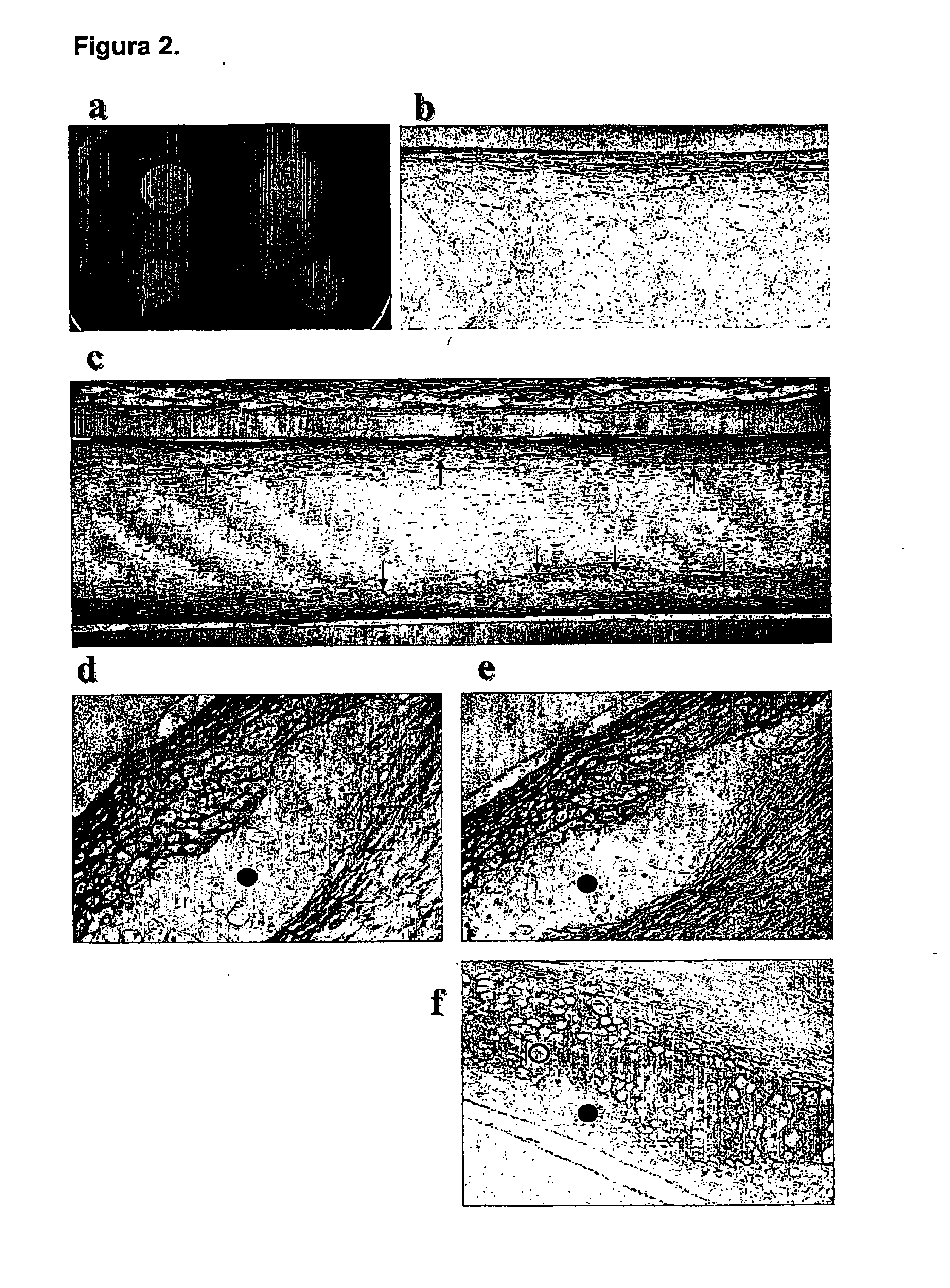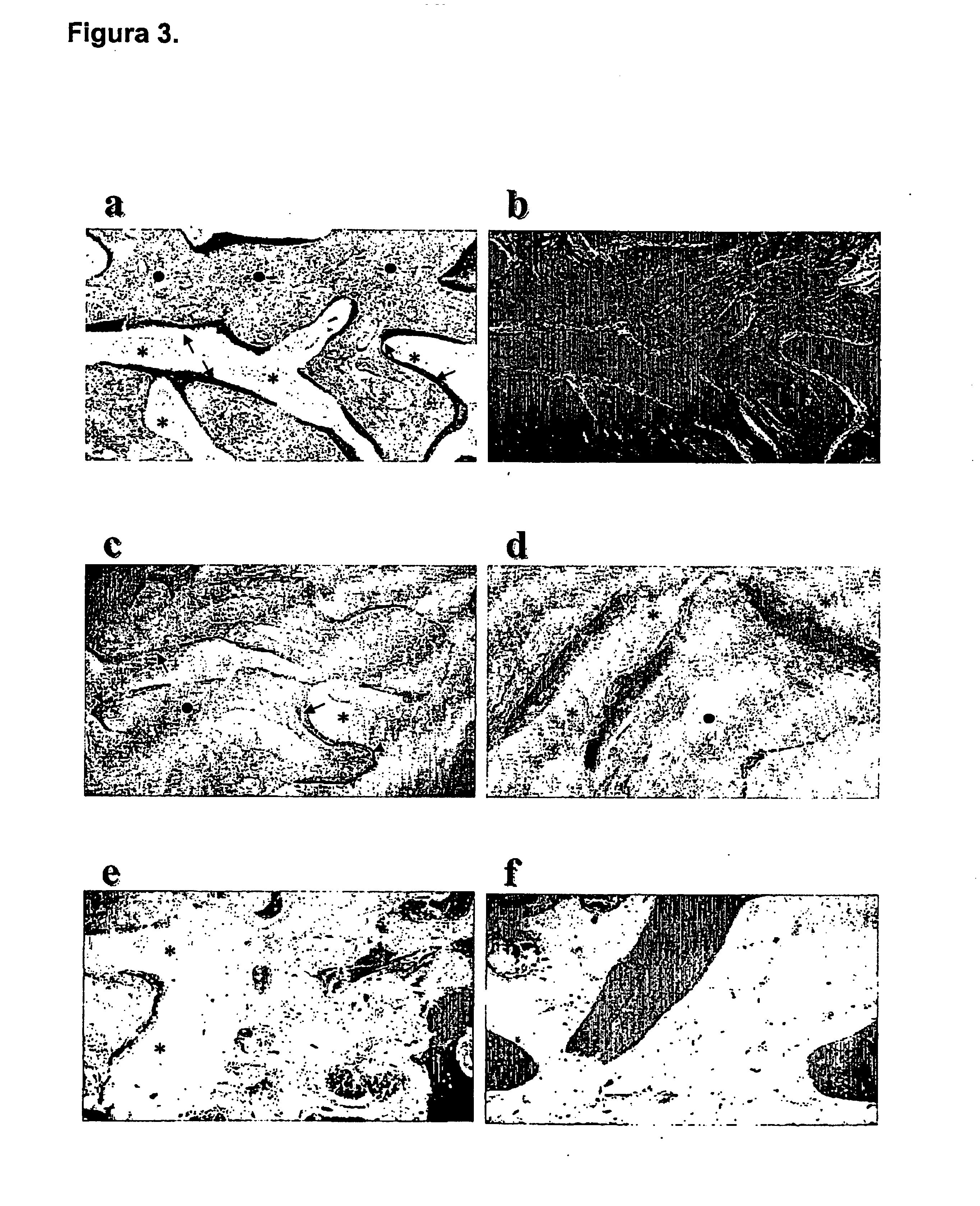Cartilage and Bone Repair Composition
a cartilage and bone technology, applied in the biomedical industry, can solve the problems of osteogenic lineage, significant gaps, and substantial reduction of mscs, and achieve the effects of enhancing the biological integration of these prostheses, prolonging their life, and promoting cartilage or bone formation
- Summary
- Abstract
- Description
- Claims
- Application Information
AI Technical Summary
Benefits of technology
Problems solved by technology
Method used
Image
Examples
example 1
Design and Obtention of the Human Fusion Recombinant Protein TGF-β1 with a Collagen I Binding Domain (rhTGF-β1-CBD).
[0032] The cDNA for the TGF-β1 gene was obtained by RT-PCR, using a DNA-polymerase with corrective capacity. The template used was total RNA, extracted by the method of Chomczynski and Sacchi (1987), from human osteosarcoma cells MG63 (ref. in ATCC: CRL-1427). The primers are designed with the aid of a software (Oligo v6.6) from the mRNA sequences published in the genbank. The PCR products were cloned “in dull” in a maintenance plasmid (pBSK II, Stratagene). Once the genes were cloned, they were checked by sequencing of both threads. Using these plasmids as template, they were amplified by PCR with pfu-DNA-polymerase, the region coding for the mature peptide. The primers used contain the Collagen-Binding Domain (CBD) and restriction sites adequate to clone directionally in a transfer plasmid of an expression system in baculovirus, containing a sequence for a peptide s...
example 2
Obtaining and Preparing Human Mesenchymal Stem Cells
[0039] Human mesenchymal stem cells were obtained from human bone marrow (BM) after surgical extraction of the iliac crest from informed donors. The marrow tissue was washed in complete medium (□-MEM, GIBCO, HD, US), with antibiotics (100 mg / mL penicillin G (sigma), 50 mg / mL gentamycin (sigma) and 0.3 mg / ml of fungizone (Flow-ICN)). The suspension of individualized cells was obtained after sequential dispersing through needles of gauge 18, 20 and 22, and finally filtered through 20 micrometer Teflon sterile filters (Cell Strainer, Falcon, Lincoln Park, N.J.) for separating tissue rests and cell accumulations.
example 3
Culture of MSCs in Collagen Gels
[0040] The cell suspension obtained according to example 2 was centrifuged at 100 g for 5 min. The centrifuge was resuspended in culture medium with a very low concentration of serum of the patient (HS, 0.5%).
[0041] Before placing the cells in the culture wells, plates of 48, 100 mL of a human collagen I solution (Sigma-Aldrich) were placed at the bottom of them, at a concentration of 0.35 mg / mL, at pH 7.4. 150 mL per well of a mixture of collagen I, TGF-β1 at a concentration of 1 mg / mL, and 2×106 bone marrow cells were placed over a layer. The culture plates were placed in the culture oven at 37° C. for 15 minutes to allow for formation of the collagen gel that was liquid until that time. Then 10 mL per well of culture medium were placed, also containing the same concentration of TGF-β1. The cultures thus arranged were cultured in an atmosphere of 95% of air and 5% of CO2, at 37° C. and 100% relative humidity. Every 3 days, the culture medium was c...
PUM
| Property | Measurement | Unit |
|---|---|---|
| Fraction | aaaaa | aaaaa |
| Fraction | aaaaa | aaaaa |
| Fraction | aaaaa | aaaaa |
Abstract
Description
Claims
Application Information
 Login to View More
Login to View More - R&D
- Intellectual Property
- Life Sciences
- Materials
- Tech Scout
- Unparalleled Data Quality
- Higher Quality Content
- 60% Fewer Hallucinations
Browse by: Latest US Patents, China's latest patents, Technical Efficacy Thesaurus, Application Domain, Technology Topic, Popular Technical Reports.
© 2025 PatSnap. All rights reserved.Legal|Privacy policy|Modern Slavery Act Transparency Statement|Sitemap|About US| Contact US: help@patsnap.com



